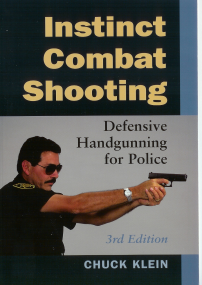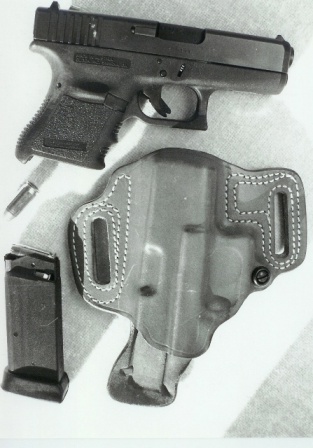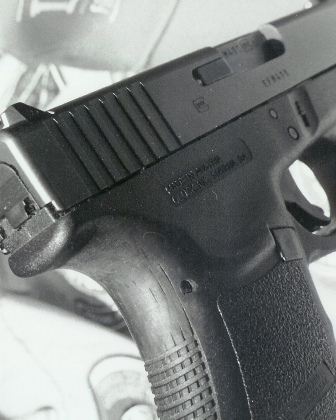GLOCK: THERE'S A REASON WHY THEY'RE SO POPULAR
Published: GunWeek Magazine 10 July 2002
© 2002 Chuck Klein
In my capacities as a licensed private investigator and as a former police officer, I have carried a concealed firearm - on or off the job - wherever I've gone for over 30 years. Though I've never shot anyone, I - like most of us in these professions - have had occasion to "use' a handgun to save my own hide.
.jpg) There are a lot of "cute" or heavy-on-the-bells-and-whistles guns out there, but when you carry for survival - all day, every day - there are only three things that matter: weight, reliability and fit. Aside from being uncomfortable, a carry gun too heavy for your frame, will cause a loss of concentration when having to shift the gun's position or compensate for the discomfort in other ways. As an investigator, losing focus during a critical time could not only jeopardize the case, but your life as well. Reliability, goes without saying. Most (not all) modern guns from any of the major manufacturers are very reliable. Reliability, also includes stopping power inasmuch as a self-defence gun, even if it functioned with every pull of the trigger, would be of little use if it were of such a lesser caliber that it couldn't be counted on for stopping a lethal force assault.
There are a lot of "cute" or heavy-on-the-bells-and-whistles guns out there, but when you carry for survival - all day, every day - there are only three things that matter: weight, reliability and fit. Aside from being uncomfortable, a carry gun too heavy for your frame, will cause a loss of concentration when having to shift the gun's position or compensate for the discomfort in other ways. As an investigator, losing focus during a critical time could not only jeopardize the case, but your life as well. Reliability, goes without saying. Most (not all) modern guns from any of the major manufacturers are very reliable. Reliability, also includes stopping power inasmuch as a self-defence gun, even if it functioned with every pull of the trigger, would be of little use if it were of such a lesser caliber that it couldn't be counted on for stopping a lethal force assault.
Fit takes in proper holster-to-body compatibility as well as fit to the eye/hand. The goal of a defensive arm is that will go from concealed carry to placing center body hits - before being incapacitated by your assailant. Any firearm relied upon for self-defense must come into battery pointing at the target without readjusting the grip or lining up the sights. If your eyes are looking at the target, that is where the gun should be pointing after you draw. You should be able to draw your gun and hit a 12-inch square at 7 yards without using your sights or changing your grip, regardless of whether the target is in front, behind or to your side.
I've known for a long time that the GLOCK series of pistols were very popular - especially with the police. But, I've resisted securing one for testing and evaluation because, well, I hate to be a follower, it might be just a fad and...I'm a wheel-gun man at heart.
 During a training session at Tactical Defense Institute where I teach my speciality, Instinct Combat Shooting, I was offered a chance to shoot a fellow instructor's GLOCK. It was love at first shot!
During a training session at Tactical Defense Institute where I teach my speciality, Instinct Combat Shooting, I was offered a chance to shoot a fellow instructor's GLOCK. It was love at first shot!
Most of the instructors carry GLOCKs and I was always a standout with my Dan Wesson .357 magnum. However, I was never at a disadvantage with my revolver as I could, even at my advanced age (60), match the other instructors, to wit: The 3-shot/3-target timed fire exercise.
Here, a timer is held to the hearing protector of the shooter. Upon hearing the starting tone, the shooter must, from the chest ready position, react and then shoot three times at three different targets (all 21 feet distance).
The goal is to do it in under one second. Very few can - most being in the 1.5 - 2 second range. My best - with the revolver - was 1.08. Most students, by the time they complete level 5 of the TDI course, shoot in the under 2 second range.
Though I haven't had the opportunity to test my skill and reaction time on the 3-shot trial with the GLOCK, I have no doubt, after some 600 rounds of practice, plinking and analyzing, I will be most competitive. The test ammunition I used was Hornady 185gr JHP/XTP because of their uniformity and accuracy. There were no miss-feeds, jams or malfunctions of any kind throughout the testing.
Most manufacturers allow writers to purchase the supplied test weapon (a used gun - after the testing) at a significant discount. I can't keep all guns due to space and money constraints, but this one's a keeper and is fast becoming a main carry piece.
The Glock system was developed by Gaston Glock, c. 1980, for the Austrian Army. Being in a country that is short of steel mills, they were looking for a firearm that could be produced with non-strategic materials - such as polymer. The GLOCK Model 17, in 9mm Luger, was the result. In 1984 the pistol surpassed all NATO durability and strength standards and has now been accepted as the issue arm of other nations.
Glock, Inc. USA, was formed in 1990 to service the huge demand of American police and sport shooters. Today, Glock offers 15 basic models in three sizes (full, compact, sub-compact) in calibers of 9x19, .40, .357 Sig, 10mm, .45 ACP. Options include: compensated barrels, adjustable sights, Trijicom night sights and Meprolight night sights. Retail prices range from $641.00 (M17) to $700.00 (M36).
 With such a popular line of firearms, holsters makers have been fighting to fill the demand. Like everything else, there's good and not-so-good ones. The pictured leather holster by HIGH NOON is the best of many I tried. The molded, double stitched rig (shown upside down in the photo) incorporates a 'slide-guard'. This unique feature keeps the metal away from body and skin. Gun oils can damage clothing and body perspiration can damage the metal parts. In addition, the 'slide-guard' separates a cold gun from warm skin. Nothing is more uncomfortable, during cold Midwestern winters, than placing cold steel next to warm skin, even if covered by a shirt. Cold metal and a warm body yield rust generating condensation.
With such a popular line of firearms, holsters makers have been fighting to fill the demand. Like everything else, there's good and not-so-good ones. The pictured leather holster by HIGH NOON is the best of many I tried. The molded, double stitched rig (shown upside down in the photo) incorporates a 'slide-guard'. This unique feature keeps the metal away from body and skin. Gun oils can damage clothing and body perspiration can damage the metal parts. In addition, the 'slide-guard' separates a cold gun from warm skin. Nothing is more uncomfortable, during cold Midwestern winters, than placing cold steel next to warm skin, even if covered by a shirt. Cold metal and a warm body yield rust generating condensation.
Aside from it's polymer frame, which is fitted with treated steel slide rails, it is the 'safe-action' firing system that makes it mechanically unique. This double-action-only trigger system offers the distinct benefits of optional trigger pulls.
Most DAO pistols have only one setup: long and hard. I set my sample to a 5.5 pound trigger pull with only a 3/8" distance. By way of comparison, my SIG Sauer P230 has a 8 pound pull of 1.2" and my AMT Backup is at 9 pounds and 3/4" distance. The AMT and the SIG, like most other semi-autos, do not have adjustable triggers.
Light short trigger pulls are nothing new - on single action pistols where manual safeties are incorporated into the design. Manual safeties combined with a single action function can be a detriment inasmuch as manipulating the safety takes time. A weapon with less than a 3 pound trigger pull (common for SA pistols) might be subject to accidental discharge. However, the GLOCK utilizes three independent and automatic safeties. There are no manual safeties - no levers, switches or buttons to manipulate before firing a shot - just pull the trigger on the loaded pistol. The three safeties are to control the trigger, firing pin and an inertia safety to guard against a dropped (or severely jarred) weapon.
 Why is it so popular? Three words: Simplicity, ergonomics, reliability. Simplicity of design and function. Here the designers used only 34 parts. With fewer parts to malfunction or break, the reliability factor is enhanced. GLOCKs work - period. On the range at TDI, and aside from occasional ammunition (reloads) failure, there were virtually no malfunctions of GLOCK pistols - mine, other instructors or students. The pistol is as reliable as a revolver. Ergonomically the gun just plain fits. With it's ambidextrous finger groves, thumb lock and trigger finger indent to its natural grip angle this gun shoots where it points and points where you look.
Why is it so popular? Three words: Simplicity, ergonomics, reliability. Simplicity of design and function. Here the designers used only 34 parts. With fewer parts to malfunction or break, the reliability factor is enhanced. GLOCKs work - period. On the range at TDI, and aside from occasional ammunition (reloads) failure, there were virtually no malfunctions of GLOCK pistols - mine, other instructors or students. The pistol is as reliable as a revolver. Ergonomically the gun just plain fits. With it's ambidextrous finger groves, thumb lock and trigger finger indent to its natural grip angle this gun shoots where it points and points where you look.

The back strip, being of Polymer, made filing for custom finger placement a easy home project.
Additionally, the polymer grip is very easy to file and sand slight changes to enhance finger placement. My fingers are on the short side of normal, but I had no problem mating the Model 36 to my hand by removing about a 1/16" from the backstrap and elongating the trigger finger grove on the right side.
For more information contact your dealer or:
GLOCK, USA
6000 Highlands Parkway
Smyrna, GA 30082
770/432-1202
www.glock.com
See TACTICAL WEAPONS by Chuck Klein